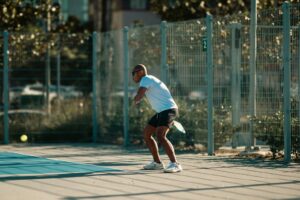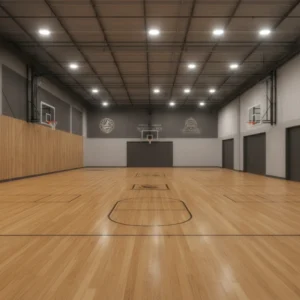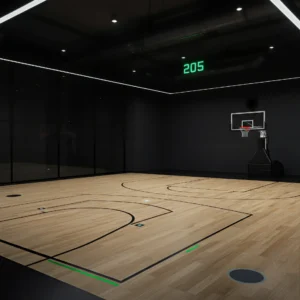High-quality basketball court flooring is the foundation of any superior athletic facility. Beyond offering professional-grade performance, it ensures player safety, enhances game longevity, and delivers a premium sporting experience. For facility managers and owners, choosing the right flooring is not just an upgrade; it’s a long-term investment in your court’s usability and reputation. This guide will provide you with everything you need to know to make an informed and confident flooring choice.

Understanding Your Needs
Before selecting basketball court flooring, it’s crucial to consider a few key factors to align the flooring choice with your facility’s specific demands.
1. Usage and Performance Requirements
What will the space be primarily used for?
A court for professional games or high-performance training requires a surface that meets official standards, such as FIBA-certified wooden floors. On the other hand, a multi-purpose space may benefit from more versatile options like modular synthetic flooring that can accommodate a variety of sports and events.
2. Budget
Budgetary constraints will influence your choice significantly. Hardwood sports flooring, while premium in performance, may have higher upfront and long-term maintenance costs compared to modular tiles or synthetic sports flooring.
3. Maintenance & Durability
Consider the ease of cleaning and maintenance. Courts in high-traffic facilities benefit from low-maintenance, waterproof sports flooring. Durability also matters—wooden sports floors offer unmatched longevity when maintained properly, while synthetic or modular options provide cost-effective durability.
4. Environment Suitability
Indoor basketball courts may use wooden sports floors for their aesthetic and playing characteristics, but high-moisture or multipurpose settings require waterproof sports flooring to combat environmental challenges.

Types of Basketball Court Flooring
The type of flooring you choose can significantly impact the performance, aesthetics, and cost-efficiency of your basketball court. Below is a detailed breakdown of the leading options.
1. Hardwood Flooring
This classic choice is the standard for professional and collegiate games.
Advantages
- Unmatched Performance: Provides optimal ball bounce and traction.
- Aesthetic Appeal: Adds a classic, polished look to any indoor sports court.
- Proven Durability: With excellent care, hardwood floors can last decades.
Disadvantages
- Maintenance Intensity: Requires regular cleaning and refinishing.
- Sensitive to Moisture: Not ideal for facilities prone to humidity.
Best for: Professional stadiums and high-performance training facilities.
2. Synthetic Sports Flooring
This versatile option includes polyurethane and vinyl-based materials, offering flexibility and durability.
Advantages
- Cost-Effective: Generally more affordable than hardwood.
- Easy Maintenance: Resistant to most stains and scratches.
- Customizable: Can be tailored for specific colors and designs.
Disadvantages
- Less Prestige: Does not offer the same professional appearance as wood.
Best for: Multipurpose indoor basketball courts and schools.
3. Modular Sports Tiles
Interlocking modular tiles are gaining popularity for their ease of installation and flexibility.
Advantages
- Quick Installation: Can be installed or replaced rapidly.
- Weatherproof: Excellent for both indoor and outdoor applications.
- Shock Absorption: Features advanced cushioning systems to protect players.
Disadvantages
- Limited Prestige: Lacks the high-end aesthetic of hardwood.
Best for: Community facilities, outdoor courts, and multipurpose venues.
Installation Process
A successful installation ensures that your flooring meets its full performance and longevity potential. Follow these steps for an optimal upgrade:
Step 1. Site Preparation
- Inspect and level the subfloor to ensure it’s smooth and sturdy.
- Address environmental challenges like moisture by incorporating waterproof barriers if necessary.
Step 2. Material Selection
- Choose materials that best align with your court usage and facility needs. For example, opt for hardwood if prioritizing professional standards, or modular tiles for flexibility.
Step 3. Installation
- Hardwood Floors: Install in strip-by-strip sections, using adhesive and fasteners for a firm setup. After installation, sanding and sealing is required.
- Synthetic Floors: Roll out and secure with adhesive, ensuring no air bubbles.
- Modular Tiles: Use the interlocking system for seamless transitions.
Step 4. Finishing Touches
- Paint court lines and logos to create a professional, polished finish.
- Allow curing time for materials to settle and adhesive to properly bond.
Maintenance and Longevity
To get the most out of your investment, regular maintenance is key. These tips will help extend the life of your basketball court flooring:
Daily Cleaning
- Dust mop daily to remove debris and dirt that can scratch the surface.
- Use damp mopping or specialized cleaners for deeper cleans, particularly for synthetic and modular floors.
Periodic Maintenance
- Hardwood Flooring: Recoat and refinish every 2-5 years. Inspect for cracks or warping.
- Synthetic Flooring: Perform color touch-ups and repair any visible surface cracks.
- Modular Tiles: Reposition or replace damaged tiles as needed.
Environmental Control
- Maintain consistent temperature and humidity levels for wooden sports floors.
- Use protective coverings for events to prevent damage to modular or synthetic floors.
Repairs
- Promptly address damages to prevent further deterioration. For significant damages, consult a professional flooring contractor.

Choose Flooring that Elevates Your Court
Selecting the right basketball court flooring transforms a regular court into an arena for excellence. From the timeless appeal of polished hardwood floors to the versatility of synthetic and modular options, understanding your needs and knowing your choices will guide you to the perfect solution.
With proper installation and regular maintenance, you’ll ensure consistent performance and longevity that players—and supporters—will admire for years to come.
Need expert advice on your next flooring installation? Contact COPO today—we’re here to help you make the best choice for your court.









